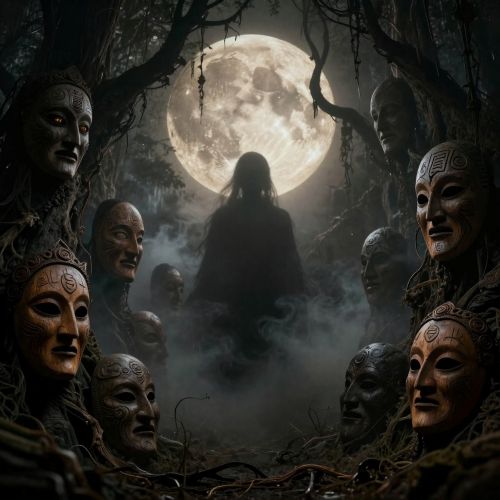Modjadji : The Rain Queen of the Balobedu
Listen
At a glance
| Description | |
|---|---|
| Origin | Lovedu Mythology |
| Classification | Gods |
| Family Members | N/A |
| Region | South African |
| Associated With | Rain, Mother |
Modjadji
Introduction
Modjadji, the legendary Rain Queen of the Balobedu people, stands as one of Africa’s most enduring symbols of sacred leadership. Her story originates in the lush region of present-day Limpopo, South Africa, where she is believed to hold the power to summon rain and restore balance to the natural world. Unlike most monarchies on the continent, the Balobedu royal lineage is strictly matrilineal, with each queen inheriting her authority directly from her mother. This continuity has preserved a centuries-old tradition that connects spiritual power, ecological stewardship, and political influence.
For the Balobedu, Modjadji is more than a ruler—she is a divine intermediary whose presence secures agriculture, fertility, and harmony. Oral traditions trace the origins of the first Rain Queen to a Karanga royal line from Zimbabwe, suggesting a heritage that blends migration, prophecy, and spiritual duty. Through generations, the institution of the Rain Queen has survived colonial interference, apartheid restructuring, and modern political shifts, remaining a powerful emblem of female sovereignty and indigenous identity.
Physical Traits
Descriptions of Modjadji’s appearance rarely focus on physical characteristics, reflecting the long-standing tradition of seclusion practiced by the queens. Historically, the Rain Queen seldom appeared in public, and portraits were limited to ceremonial occasions. This intentional withdrawal enhanced her mystique, reinforcing her role as a sacred figure rather than a conventional monarch.
When she did emerge for rituals, her attire symbolised purity, authority, and her bond with nature. She wore garments made from animal skins, beadwork that represented ancestral power, and regalia associated with rainmaking. These sacred items communicated her connection to the spiritual realm more clearly than any physical depiction could. Through this carefully maintained mystique, Modjadji’s presence was understood through reverence rather than visibility, transforming her identity into a living embodiment of her people’s beliefs.
Family
The lineage of Modjadji is preserved through mothers and daughters, making the family structure central to the sustainability of the queenship. The dynasty begins with Modjadji I in the 1800s, though its origins trace further back to the mythical stories of a Karanga princess who fled from Zimbabwe after being instructed by prophecy to establish a new nation led by women.
Each queen is raised with a deep understanding of ritual knowledge, herbal medicine, rainmaking traditions, and the responsibilities of rulership. Historically, the Rain Queen remained unmarried, with heirs conceived through discreet arrangements designed to preserve the matrilineal succession without disrupting the queen’s spiritual purity.
The royal household includes senior advisors, ritual specialists, and members of the extended royal clan who manage political matters, ceremonies, and community relations. This structure ensures that the queenship functions not only as a spiritual institution but also as an enduring system of governance within Balobedu society.
Other names
Modjadji is primarily known as the Rain Queen, a title that captures the essence of her supernatural authority. The name “Modjadji” itself is derived from the Balobedu language and is often translated as “Ruler of the Day” or “She Who Brings the Clouds.”
Throughout oral tradition, she is addressed by praise names that highlight her relationship with the natural world. Titles such as “Mother of the Clouds,” “Mist Queen,” and “Ngaka ya pula” (“Doctor of Rain”) emphasise her powers over weather, growth, and protection. Across different dialects and historical records, variations such as Madjadji, Mjanji, and Mujaji appear, but they all point to the same revered identity—one who controls the life-giving rains and maintains spiritual order in the region.
Powers and Abilities
Modjadji’s most renowned ability is her power to summon rain, a skill believed to be inherited from her ancestors. These powers are expressed through precise rituals involving sacred medicines, chants, dances, and seasonal ceremonies performed at the royal kraal. The Rain Queen’s influence is tied to ancestral spirits, and her role is understood as a bridge between the natural and supernatural realms.
Her rainmaking is more than ecological; it has historically shaped diplomacy and regional politics. Neighbouring kingdoms, including the Pedi and Tsonga, respected the Rain Queen’s ability to bring either rain or drought, often sending tribute or seeking alliances. Stories recount how she could bless allies with gentle showers or call upon storms to protect the kingdom.
Beyond weather control, Modjadji is seen as a healer, seer, and spiritual guide. Her presence embodies fertility—of people, animals, and crops. Through divination and ritual leadership, she safeguards the well-being of her people and ensures that harmony between land and community is preserved.
Modern Day Influence
The legacy of Modjadji continues to shape cultural and political life in South Africa. Despite disruptions during the apartheid era, when the queenship was reduced in status, recognition has been restored in the democratic era, affirming the Rain Queen’s role as a traditional leader. The Balobedu kingdom remains active, with community governance spread across more than 100 villages.
Modjadji’s influence extends globally. Her unique position as a female monarch has inspired novels, academic studies, documentaries, and even political commentary on matriarchal leadership. Authors like H. Rider Haggard fictionalised her legacy, while modern discussions highlight her ecological symbolism in an age marked by climate change and water scarcity.
Tourism has further elevated her cultural relevance. The Modjadji Cycad Reserve, home to ancient plants believed to be protected by the queens, attracts visitors from around the world. Her story also resonates in conversations about indigenous governance, environmental stewardship, and the preservation of African spiritual systems. Today, Modjadji remains a powerful icon of heritage and continuity, representing a living tradition that bridges the ancestral and modern worlds.
Related Images
Source
National Museum Publications. (n.d.). Modjadji – The Rain Queen. Retrieved from https://nationalmuseumpublications.co.za/modjadji-the-rain-queen/
Thingz Afrikan. (2015, April 6). Modjadji, The Rain Goddess. Retrieved from https://thingzafrikan.wordpress.com/2015/04/07/1629/
The Enlightenment Journey. (2024, May 2). The Rain Queen Modjadji: Venda Mythology in South Africa. Retrieved from https://theenlightenmentjourney.com/the-rain-queen-modjadji-venda-mythology-in-south-africa/
Ask Oracle. (2024, September 2). Modjadji – Girl Name Meaning and Pronunciation. Retrieved from https://www.ask-oracle.com/baby-name/modjadji/
Horror Chronicles. (2024, June 14). Rain Queen Modjadji: The Divine Female Monarch of the Balobedu People. Retrieved from https://horrorchronicles.com/rain-queen-modjadji/
Atlas Obscura. (n.d.). The Restoration of South Africa’s Rain Queen. Retrieved from https://www.atlasobscura.com/articles/south-africa-rain-queen
Times of India. (2017, June 10). South Africa’s pre-teen queen with ‘rainmaking’ powers. Retrieved from https://timesofindia.indiatimes.com/world/rest-of-world/south-africas-pre-teen-queen-with-rainmaking-powers/articleshow/59092468.cms
Frequently Asked Questions
Who is Modjadji in South African tradition?
Modjadji is the Rain Queen of the Balobedu people, a matrilineal ruler believed to possess supernatural control over rain.
How does Modjadji make rain?
Rainmaking involves sacred rituals using ancestral medicines, chants, dances, and ceremonies performed at the royal kraal.
Is the Modjadji queenship still active today?
Yes, the Balobedu monarchy continues today, and the Rain Queen remains a recognised traditional leader in South Africa.
Why is Modjadji important in African culture?
She symbolises female leadership, ecological harmony, and spiritual authority, making her a unique figure in global indigenous traditions.
Where can I learn more about Modjadji’s history?
The Modjadji Cycad Reserve, Balobedu oral traditions, academic works, and South African cultural archives all document her enduring legacy.





